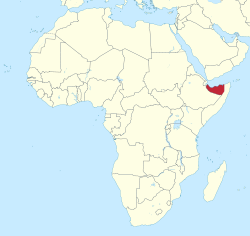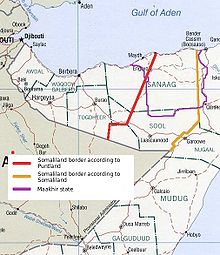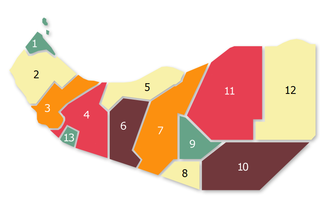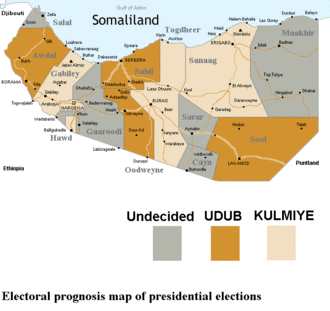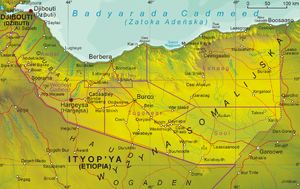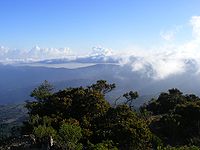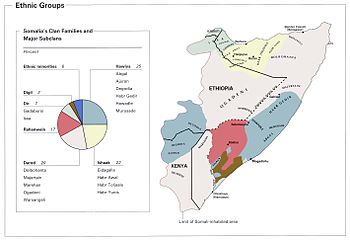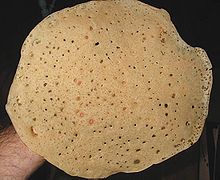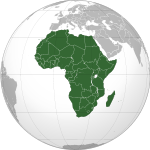- Somaliland
-
For other uses, see Somaliland (disambiguation).Somaliland
locally known as
Jamhuuriyadda Soomaaliland
جمهورية أرض الصومال
Jumhūrīyat Ṣūmāliland
Republic of Somaliland

Flag National Emblem Motto: لا إله إلا الله محمد رسول الله (Arabic)
Lā ilāhā illā-llāhu; muhammadun rasūlu-llāhi (transliteration)
"There is no god but God, and Muhammad is the Messenger of God"Anthem: Samo ku waar Capital Hargeisa
9°33′N 44°03′E / 9.55°N 44.05°EOfficial language(s) Somali, Arabic, English[1] Demonym Somali;[2] Somalian[3]
- Somalilander
Government Constitutional presidential republic - President Ahmed Mahamoud Silanyo - Vice-President Abdirahman Saylici - Speaker of the House Abdirahman Mohamed Abdilahi Independence from Somalia - Proclaimed 18 May 1991 - Recognition Unrecognized[4][5] Area - Total 137,600 km2
68,000 sq miPopulation - 2008 estimate 3,500,000[6] - Density 25/km2
51/sq miCurrency Somaliland shilling1 ( SLSH)Time zone EAT (UTC+3) - Summer (DST) not observed (UTC+3) Date formats d/m/yy (AD) Drives on the right Calling code 252 1. Currency only valid for regional purposes.
Rankings unavailable because it is unrecognised.Somaliland (Somali: Soomaaliland, Arabic: صوماللاند Ṣūmāliland) is an unrecognised self-declared sovereign state that is internationally recognised as an autonomous region of Somalia.[4][7] The government of Somaliland regards itself as the successor state to the British Somaliland protectorate, which was independent for a few days in 1960 as the State of Somaliland,[8][9] before uniting with the Trust Territory of Somalia (the former Italian Somaliland) later the same week to form the Somali Republic.[8][9][10][11][12]
Somaliland is bordered by Ethiopia in the south and west, Djibouti in the northwest, the Gulf of Aden in the north, and the autonomous Puntland region of Somalia to the east.[13]
In 1988, the Siad Barre regime committed massacres against the people of Somaliland, which were among the events that led to the Somali Civil War. The war left the economic and military infrastructure severely damaged. After the collapse of the central government in 1991, the local government, led by the Somali National Movement (SNM), declared independence from the rest of Somalia on May 18 of the same year.[4][14][15]
Since then, the territory has been governed by an administration that seeks self-determination as the Republic of Somaliland (Somali: Jamhuuriyadda Soomaaliland, Arabic: جمهورية صوماللاند Jumhūrīyat Ṣūmāliland).[1][16][17][18] The local government maintains informal ties with some foreign governments, who have sent delegations to Hargeisa.[4][19][20] Ethiopia also maintains a consulate in the region.[21] However, Somaliland's self-proclaimed independence remains unrecognised by any country or international organisation.[4][22][23]
Contents
History
Main article: History of SomalilandThe earliest human artifacts in the area are the Laas Geel cave paintings, dating from before 3000 BC. The area is sometimes thought to be part of the Land of Punt.[citation needed] Islam was introduced to the area from the 7th to 10th centuries, and small Islamic states sprang up in the area. In 1548 AD, the Ottoman Empire annexed part of what is now western Somaliland. In 1888, after signing successive treaties with the then ruling Somali Sultans such as Mohamoud Ali Shire of the Warsangali Sultanate, the British established a protectorate in the region referred to as British Somaliland.[24] The British garrisoned the protectorate from Aden and administered it as part of British India until 1898. British Somaliland was then administered by the Foreign Office until 1905, and afterwards by the Colonial Office.
Generally, the British did not have much interest in the resource-barren region.[25] The stated purposes of the establishment of the protectorate were to "secure a supply market, check the traffic in slaves, and to exclude the interference of foreign powers." [26] The British principally viewed the protectorate as a source for supplies of meat for their British Indian outpost in Aden through the maintenance of order in the coastal areas and protection of the caravan routes from the interior.[27] Hence, the region's nickname of "Aden's butcher's shop".[28] Colonial administration during this period did not extend administrative infrastructure beyond the coast,[29] and contrasted with the more interventionist colonial experience of Italian Somaliland.[30]
The British Somaliland protectorate became briefly independent on June 26, 1960, with the Trust Territory of Somalia (the former Italian Somaliland) following suit five days later.[10] On July 1, 1960, the two territories united as planned to form the Somali Republic.[11][12] A government was formed by Abdullahi Issa, with Aden Abdullah Osman Daar as President and Abdirashid Ali Shermarke as Prime Minister (later to become President, from 1967 to 1969). On July 20, 1961 and through a popular referendum, the Somali people ratified a new constitution, which was first drafted in 1960.[31] In 1967, Muhammad Haji Ibrahim Egal became Prime Minister, a position to which he was appointed by Shermarke. Shermarke would be assassinated two years later by one of his own bodyguards. His murder was quickly followed by a military coup d'état on October 21, 1969 (the day after his funeral), in which the Somalian Army seized power without encountering armed opposition. The putsch was spearheaded by Major General Mohamed Siad Barre, who at the time commanded the army.[32] The new regime would go on to rule Somalia for the next 21 years. By the 1990s, the moral authority of Barre's government had collapsed. Many Somalis had become disillusioned with life under military dictatorship. The government became increasingly totalitarian, and resistance movements, encouraged by Ethiopia, sprang up across the country, eventually leading to the Somali Civil War. Among the militia groups was the Isaaq-led Somali National Movement (SNM), based in Hargeisa.
Although the SNM at its inception had a unionist constitution, it eventually began to pursue a separatist agenda, looking to secede from the rest of Somalia. Under the leadership of Abdirahman Ahmed Ali Tuur, the local administration declared the northwestern Somali territories independent on 18 May 1991. Tuur then became the newly-established Somaliland polity's first President, but subsequently renounced the separatist platform in 1994 and began instead to publicly seek and advocate reconciliation with the rest of Somalia under a power-sharing federal system of governance.[33] Muhammad Haji Ibrahim Egal was appointed as Tuur's successor in 1993 by the Grand Conference of National Reconciliation in Borama, which met for four months, leading to a gradual improvement in security, as well as a consolidation of the new territory.[34] Egal was reappointed in 1997, and remained in power until his death on May 3, 2002. The vice president, Dahir Riyale Kahin, who was during the 1980s the highest-ranking National Security Service (NSS) officer in Berbera in Siad Barre's government, was sworn in as president shortly afterwards.[35] In 2003, Kahin became the first elected president of Somaliland.
The war in southern Somalia between Islamist insurgents on the one hand, and the Transitional Federal Government (TFG) and its African Union allies on the other, has for the most part not directly affected Somaliland, which, like neighboring Puntland, has remained relatively stable.[36]
Politics and government
Main article: Politics of SomalilandSomaliland has formed a hybrid system of governance under the Constitution of Somaliland, combining traditional and western institutions. In a series of inter-clan conferences, culminating in the Boorama Conference in 1993, a qabil(clan or community) system of government was constructed. This consisted of an Executive with a President, Vice President, and Council of Ministers, a bicameral Legislature, and an independent judiciary.
The traditional Somali council of elders (guurti) was incorporated into the governance structure, becoming the House of Elders in Parliament. The government became in essence a "power-sharing coalition of Somaliland's main clans," with seats in the Upper and Lower houses proportionally allocated to clans according to a predetermined formula, although not all clans are satisfied with their representation. In 2002, after several extensions of this interim government, Somaliland finally made the transition to multi-party democracy, with district council elections contested by six parties.[37]
The Somaliland government is headed by the executive branch, which consists of a directly-elected President, a Vice President, and a cabinet nominated by the President and approved by parliament. The President is directly elected, and Presidential elections are confirmed by the National Elections Commission.[38] The President can serve a maximum of two five-year terms. The Parliament of Somaliland is the legislative branch of government. It is a bicameral parliament. Its two houses consist of the House of Elders (Upper House) and the House of Representatives. Each house has 82 members. Members of the House of Elders are elected indirectly by local communities for six-year terms. The House of Elders shares power in passing laws with the House of Representatives, and also has the role of solving internal conflicts, and an exclusive power to extend the terms of the President and representatives under circumstances that make an election impossible. Members of the House of Representatives are directly elected by the people for five-year terms. The House of Representatives shares voting power with the House of Elders, though it can pass a law that the House of Elders rejects it votes for the law by a 2/3's majority, and has absolute power in financial matters and confirmation of Presidential appointments (except for the Chief Justice of the Supreme Court).[39] However, the Parliament provides weak oversight of the executive branch. The Somaliland judicial system is divided into district courts (which deal with matters of family law and succession, lawsuits for amounts up to 3 million SL, criminal cases punishable by up to 3 years imprisonment or 3 million SL fines, and crimes committed by juveniles), regional courts (which deal with lawsuits and criminal cases not within the jurisdiction of district courts, labour and employment claims, and local government elections), and appeals courts (which deal with all appeals from district and regional courts). The highest court is the Somaliland Supreme Court, which deals with issues between courts and in government, and reviews its own decisions. Supreme Court justices also constitute the Somaliland Constitutional Court, which deals with constitutional matters.[40]
Somaliland has three political parties: the United Peoples' Democratic Party, the Peace, Unity, and Development Party, and the Justice and Development Party. Under the Somaliland Constitution, a maximum of three political parties are allowed, and parties defined by religion or clan are prohibited, though all three parties are closely affiliated with a clan.[41]
Foreign relations
Main article: Foreign relations of SomalilandSomaliland has political contacts with its neighbours Ethiopia,[42][43] and Djibouti,[44] as well as with Belgium,[43] France,[45] Ghana,[43] Kenya,[46] South Africa,[43] Sweden,[43][47] and the United Kingdom.[43][48] On 17 January 2007, the European Union (EU) sent a delegation for foreign affairs to discuss future cooperation.[49] The African Union (AU) has also sent a foreign minister to discuss the future of international acknowledgment, and on January 29 and 30, 2007, the ministers stated that they would discuss acknowledgement with the organisation's member states[50] In June 2007, Ethiopian Prime Minister Meles Zenawi held a conference with Somaliland's President Kahin, during which he was referred to in an official communique by the Ethiopian Foreign Ministry as the President of Somaliland, the first time that Somaliland has been officially referred to as a sovereign state by a foreign government. While this is not claimed as a move to official recognition by Ethiopia, it is seen as a possible step toward a unilateral declaration by Ethiopia in the event of the AU failing to move its recognition of Somaliland forward.[43]
In 2007, a delegation led by President Kahin was present at the Commonwealth Heads of Government Meeting in Kampala, Uganda. Although Somaliland has applied to join the Commonwealth under observer status, its application is still pending.[51]
On November 27, 2007, Annemie Neyts-Uyttebroeck of the ELDR, one of three main parties in the EU, mailed a letter to the then-EU High Representative Javier Solana, and to President Kahin of Somaliland, which called upon the EU to recognise Somaliland.[52] In December 2007, the United States government discussed whether to back the shaky transitional government in Mogadishu or to acknowledge and support the less volatile Somaliland secessionists.[53]
In early 2006, the National Assembly of Wales extended an official invitation to the Somaliland government to attend the royal opening of the Senedd in Cardiff. The move was seen as an act of recognition by the Welsh Assembly of the breakaway government's legitimacy. The Foreign and Commonwealth Office made no comment on the invitation. Wales is home to a significant Somaliland expatriate community.[54]
On September 24, 2010 Johnnie Carson, Assistant Secretary of State for African Affairs, stated that the United States would be modifying its strategy in Somalia and would seek deeper engagement with the governments of Somaliland and Puntland while continuing to support the Somali Transitional Government.[55] Carson said the US would send aid workers and diplomats to Puntland and Somaliland and alluded to the possibility of future development projects. However, Carson emphasized that the U.S. would not extend formal recognition to either region.[56] The current UK Minister for Africa, Henry Bellingham MP, met President Silanyo of Somaliland in November 2010 to discuss ways in which to increase the UK's engagement with Somaliland.[57] President Silanyo said during his visit to London: "We have been working with the international community and the international community has been engaging with us, giving us assistance and working with us in our democratisation and development programmes. And we are very happy with the way the international community has been dealing with us, particularly the UK, the US, other European nations and our neighbours who continue to seek recognition.”[58]
Border disputes
Main article: Puntland–Somaliland disputeSomaliland continues to claim the entire area of the former British Somaliland.[14] It is currently in control of the western half of the former British Somaliland, with northeastern Maakhir having declared itself a separate, unrecognised autonomous state within Somalia in July 2007, and the disputed southeastern Sool state had been under the control of neighbouring Puntland from 2003 until 2008.[59] A coalition of Dir intellectuals hailing from the westernmost Awdal province have threatened to secede if Somaliland's independence is recognised.[60][61]
Tensions between Puntland and Somaliland escalated into violence several times between 2002 and 2009. In October 2004, and again in April and October 2007, armed forces of Somaliland and Puntland clashed near the town of Las Anod, the capital of Sool region. In October 2007, Somaliland troops took control of the town.[62] While celebrating Puntland's 11th anniversary on 2 August 2009, Puntland officials vowed to recapture Las Anod. While Somaliland claims independent statehood and therefore 'split up' the 'old' Somalia, Puntland works for the re-establishment of a united but federal Somali state.[63]
Somaliland forces took control of the town of Las Qorey in eastern Sanaag on 10 July 2008, along with positions five kilometers east of the town. The defence forces completed their operations on 9 July 2008 after the Maakhir and Puntland militia in the area left their positions,[64] but control of the territory was later assumed by Puntland as Maakhir was incorporated into the autonomous region in January 2009.[65]
In the late 2000s, HBM-SSC (Hoggaanka Badbaadada iyo Mideynta SSC), a local unionist group based in Sanaag was formed with the goal to establish its own regional administration (Sool, Sanaag and Cayn, or SSC).[33]
In 2010, the formation of a new autonomous region within a federal Somalia was also declared in the Awdal province. Referred to as Awdalland or the Adal State, the local administration does not recognise the Somaliland government's claim to sovereignty or to its territory.[66][67]
Military
Main article: Military of SomalilandThe Somaliland Armed Forces are the main military command in Somaliland, and, along with the Police Force and all other internal security forces, are overseen by Somaliland's Ministry of Defence. The current head of Somaliland's Armed Forces is the Minister of Defence, Mudane Adan Mire Mohammed. The commanding of the military comes under a civilian post and not a military general.
The Somaliland Army consists of twelve divisions equipped primarily with light weaponry, though it is equipped with some howitzers and mobile rocket launchers. Its armored vehicles and tanks are mostly of Soviet design, though there are some aging Western vehicles and tanks in its arsenal. The Somaliland Air Defense Forces operate mostly Soviet aircraft and radars, though it also uses the Spanish CASA C-212 Aviocar transport plane. The Somaliland Navy has an arsenal of well-armed vessels and highly trained sailors, with the Berbera Marine College producing highly-qualified naval officers who operate under International Maritime Bureau regulations.[68]
Administrative divisions
Main article: Regions of SomalilandKey Region Capital Area
km²Population
density
km21 Salal Zeila n/a n/a 2 Awdal Borama n/a n/a 3 Gabiley Gabiley n/a n/a 4 Gaaroodi Salahley n/a n/a 5 Sahil Berbera n/a n/a 6 Odweyne Odweyne n/a n/a 7 Togdheer Burao n/a n/a 8 Cayn Buuhoodle n/a n/a 9 Sarar Caynaba n/a n/a 10 Sool Las Anod n/a n/a 11 Sanaag Erigavo n/a n/a 12 Maakhir Badhan n/a n/a 13 Hawd Baligubadle n/a n/a 14 Maroodi Jeex Hargeisa n/a n/a The main cities and towns in Somaliland:
- Hargeisa (Hargeysa), capital
- Boorama (Borama)
- Berbera
- Burco (Burao)
- Ceerigaabo (Erigabo)
- Dilla
- Las Anod (Laascaanood)
- Gabiley (Gabileh)
- Baligubadle
- Zeila (Saylac)
- Odweyne
- Yubbe
- Badhan
- Lasqoray
State Capital Annexed Gabiley Gabiley Maroodi Jeex Maakhir Badhan Sanaag Cayn Buhoodle Togdheer Salal Zeila Awdal Sarar Caynaba Sool Odweyne Odweyne Togdheer Hawd Baligubadle Maroodi Jeex 16 new Districts:
District Region Annexed Region Haji Salax Odweyne Togdheer Kalabaydh Sool region – Wajale Gabile Hargeysa Widh-widh Buhoodle Sool Qorulugad Buhoodle Togdheer Go’Da Weyne Sahil – Harasheekh Odweyne Togdheer Raydab Khatumo Odweyne Togdheer Garba Dardar Salal Awdal Boon Sala Awdal Harirad Salal Awdal Las Idle Sahil – War Idad Sarar Togdheer Yubbe Sanaag Maakhir Elal Sarar Togdheer War Imran Togdheer – Magalo Ad Awdal – Geography
Somaliland is situated in the Horn of Africa. It lies between the 08°00' – 11°30' parallel north of the equator and between 42°30' – 49°00' meridian east of Greenwich. It is bordered by Djibouti to the west, Ethiopia to the south, and the Puntland region of Somalia to the east. Somaliland has a 740 kilometres (460 mi) coastline with the majority lying along the Gulf of Aden. The region is slightly larger than England, with an area of 137,600 km2 (53,128 sq mi).
Somaliland's climate is a mixture of wet and dry conditions. The northern part of the region is hilly, and in many places the altitude ranges between 900 and 2,100 metres (2,953 and 6,890 ft) above sea level. The Awdal, Saaxil and Maroodi Jeex (formerly known as Woqooyi Galbeed, as shown on the accompanying map) regions are fertile and mountainous, while Togdheer is mostly semi-desert with little fertile greenery around. The Awdal region is also known for its offshore islands, coral reefs and mangroves.
10 kilometres (6.2 mi) to the north of Ceerigaabo is the Cal Madow range, running along the edge of the escarpment, which looks down to the Gulf of Aden. It is about 2,000 metres (6,562 ft) above sea level, where the road from Ceerigaabo drops down to the coast. 2 kilometres (1.2 mi) to the west it rises to the highest point in Somaliland and Somalia alike; at 2,416 metres (7,927 ft) high, it is known variously as Shimbiris or Shimbir Beris, which translates as the abode of the birds. The Cal Madow range receives considerably more precipitation than the rest of Somaliland and hosts a dense forest home to numerous endemic species.
Due to the fertility and greenery of some of the regions of Somaliland, wild animals come to the area either to breed or to graze on the grassland savanna. There are many animals that are native to Somaliland. Prominent animals are the kudu, wild boar, Somali Wild Ass, warthog, antelope, the Somali sheep, wild goat, camel, lion and cheetah. There is also the largest world population of caracals in the Burco area. Moreover, many birds and different types of fish are also found in and around Somaliland.
Extreme recorded temperatures range from −3.3 °C (26.1 °F) at Ceerigaabo to 47.7 °C (117.9 °F) at Berbera. The combination of a yearly average temperature of 31 °C (87.8 °F) and the high level of humidity makes Berbera one of the hottest cities in the world.
Economy
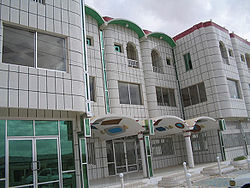 A shopping mall in Hargeisa
A shopping mall in Hargeisa
Somaliland's economy is in its developing stages, as is the region itself. The Somaliland shilling, while stable, is not an internationally recognised currency and currently has no official exchange rate. It is regulated by the Bank of Somaliland, the central bank, which was established constitutionally in 1994.
Since Somaliland is unrecognised, international aid donors have found it difficult to provide aid. As a result, the government relies mainly upon tax receipts and remittances from the large Somali diaspora contribute immensely to Somaliland's economy.[69] Remittances come to Somaliland through money transfer companies (locally known as hawalad), the largest of which is Dahabshiil, one of the few Somali money transfer companies to conform to modern money-transfer regulations. The World Bank estimates that remittances worth approximately $US 1 billion reach Somalia annually from emigres working in the United States, Europe, and the Gulf states. Analysts say that Dahabshiil may handle around two-thirds of that figure, and that as much as half of it reaches Somaliland alone.[70]
Since the late 1990s, service provision has significantly improved as a result of limited government provision and contributions from non-governmental organisations, religious groups, the international community (especially the Diaspora) and the growing private sector. Local and municipal governments have been developing the provision of key public services, such as water in Hargeisa and education, electricity and security in Berbera.[69] In 2009, the Banque pour le Commerce et l'Industrie – Mer Rouge, based in Djibouti, opened a branch in Hargeisa, to become the first bank in the country since the collapse in 1990 of the Commercial and Savings Bank of Somalia.
The port city of Berbera
The bulk of Somaliland's exports are livestock, which has been estimated at 24 million.[clarification needed] In 1996, 3 million heads of livestock were exported to the Middle East. In February 1998, this export was greatly affected by a Saudi Arabian ban on imports of beef. The ban was eventually lifted in December 2006, allowing the industry to recover. Other exports include hides, skins, myrrh, and frankincense. Economic activity has been facilitated by the protection of key transport corridors and infrastructure, especially sea and air ports such as the Berbera port, even during times of increased conflict.
Agriculture is generally considered to be a potentially successful industry, especially in the production of cereals and horticulture. Mining also has potential, though simple quarrying represents the extent of current operations despite the presence of hugely diverse quantities of mineral deposits.[1]
Since the Eritrean-Ethiopian War, Somaliland has grown as a major export port for Ethiopia. Ethiopia has signed a contract with the Somaliland government, specifying that the port city of Berbera will export goods from, and import goods destined for, Ethiopia.
Tourism
Main article: Tourism in Somaliland The Burao countryside en route to Berbera.
The Burao countryside en route to Berbera.
Somaliland has a budding tourist industry and is home to what is often considered to be one of the most interesting attractions in the Horn of Africa, the Laas Gaal cave paintings. Currently, a small number of tourists travel to the region to see this sight. The paintings are situated near Hargeisa and were discovered by a French archaeological team in 2002. The government and locals keep the cave paintings safe, and only a restricted number of tourists are allowed entry. Other notable sights include the Freedom Arch in Hargeisa and the war memorial in the city centre. Natural attractions are very common around the region. The Naasa Hablood are twin hills located on the outskirts of Hargeisa that Somalis in the region consider to be a majestic natural landmark.
The Ministry of Tourism has also encouraged travellers to visit historic towns and cities in Somaliland. The historic town of Sheekh is located near Berbera and is home to old British colonial buildings that have remained untouched for over forty years. Berbera also houses historic and impressive Ottoman architectural buildings. Another equally famous historic city is Zeila. Zeila was once part of the Ottoman Empire, a dependency of Yemen and Egypt and a major trade city during the 19th century. The city has been visited for its old colonial landmarks, offshore mangroves and coral reefs, and its towering cliffs and beach. The nomadic culture of Somaliland has also attracted tourists. Most nomads live in the countryside.
Transport
Bus services operate in Hargeisa, Burao, Gabiley, Berbera and Borama. There are also services between the major towns and adjacent villages operated by different types of vehicles such as 4 wheel drives and light goods vehicles (LGV). The most prominent airline in Somaliland is Daallo Airlines, due to the demise of Somali Airlines following the Somalian civil war. It flies to Djibouti, Dubai, Jeddah, and Addis Ababa, as well as operating flights for Hajj and Umrah pilgrimages.
Demographics
Languages
Main article: Languages of SomalilandMost people in Somaliland speak two of the three official languages: English, Somali and Arabic. Article 6 of the Constitution of 2001 designates the official language of Somaliland to be Somali,[14] though Arabic is a mandatory subject in school and is used in mosques around the region and English is spoken and taught in schools. English was proclaimed an official language later, outside the constitution.[71]
Somali belongs to a set of languages called Lowland East Cushitic languages spoken by Somalis living in Somalia, Djibouti, and in adjacent territories. Eastern Cushitic is one branch of the Cushitic languages, which in turn are part of the great Afro-Asiatic stock. Arabic is the most widely spoken language of the Afro-Asiatic language family.
The main Somali dialect that is the most widely used is Standard Somali, a term applied to several sub-dialects, the speakers of which can understand each other easily. Standard Somali is spoken in most of Somalia and in adjacent territories (Djibouti, Ogaden, northeast Kenya), and is used by broadcasting stations in the Somaliland region.
Facility with language is highly valued in Somali society; the capability of a suitor, a warrior, or a political or religious leader is judged in part by his verbal adroitness. In such a society, oral poetry becomes an art, and one's ability to compose verse in one or more of its several forms enhances one's status. Speakers in political or religious assemblies and litigants in courts traditionally were expected to use poetry or poetic proverbs. Even everyday talk tended to have a terse, vivid, poetic style, characterised by carefully chosen words, condensed meaning, and alliteration.
In the pre-revolutionary period, English became dominant in the school system and in government. However, the overarching issue was the development of a socio-economic stratum based on mastery of a foreign language. The relatively small proportion of Somalis (less than 10 percent) with a grasp of such a language—preferably English—had access to government positions and the few managerial or technical jobs in modern private enterprises. Such persons became increasingly isolated from their nonliterate Somali-speaking brethren, but because the secondary schools and most government posts were in urban areas the socio-economic and linguistic distinction was in large part a rural-urban one.
Even before the 1969 revolution, Somalis had become aware of social stratification and the growing distance, based on language and literacy differences, between ordinary Somalis and those in government. The 1972 decision by the government of Somalia to designate an official Somali alphabet and require its use in government demolished the language barrier and an important obstacle to rapid literacy growth.
In the years following the institution of the Somali Latin script, Somali officials were required to learn the orthography and attempts were made to inculcate mass literacy—in 1973, among urban and rural sedentary Somalis, and in 1974–75, among nomads. Although a few texts existed in the new script before 1973, in most cases new books were prepared presenting the government's perspective on Somali history and development. Somali scholars also succeeded in developing a vocabulary to deal with a range of subjects from mathematics and physics to administration and ideology.
Religion
See also: Islam in Somaliland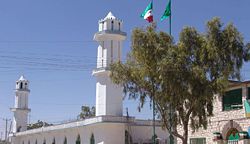 Hargeisa central mosque.
Hargeisa central mosque.
With few exceptions, Somalilanders are entirely Muslims,[72][73] the majority belonging to the Sunni branch of Islam and the Shafi'i school of Islamic jurisprudence.[74] As with southern Somali coastal towns such as Mogadishu and Merca, there is also a presence of Sufism, Islam's mystical dimension; particularly the Arab Rifa'iya tariiqa.[75] Though traces of pre-Islamic traditional religion exist in Somaliland, Islam is important to the Somali sense of national identity. Many of the Somali social norms come from their religion. For example, Somali women wear a hijab when they are in public. In addition, Somalis abstain from pork and alcohol, and also try to avoid receiving or paying any form of interest (usury). Muslims generally congregate on Friday afternoons for a sermon and group prayer.
Under the Constitution of Somaliland, Islam is the state religion of Somaliland, and no laws may violate the principles of Sharia. The promotion of any religion other than Islam is illegal, and the state promotes Islamic tenets and discourages behavior contrary to Islamic morals.[76]
Somaliland has very few Christians, and most have come from the schools and orphanages of the Roman Catholic missions of Aden, Djibouti, and of Berbera;[77] the closest current diocese of any denomination is the Roman Catholic Diocese of Djibouti, to the north of Somaliland. No organized church operates in the territory. The Holy See does not recognize Somaliland as a sovereign state.
The colonial period saw some Roman Catholic missionary activity in Somaliland. British Somaliland was under the care of the Vicariate Apostolic of Arabia, as also the Vicariate Apostolic of the Gallas (including French Somaliland and the main territory of Ethiopia), confided to the Order of Friars Minor Capuchin. Italian Somaliland was detached in 1904 from the Vicariate Apostolic of Zanzibar, erected into the Prefecture Apostolic of Benadir, and confided to the ancient Order of the Holy Trinity or Trinitarians.
Culture
Main article: Culture of SomalilandClan system
There are about 3.5 million people in Somaliland. Somali society is organised into clans, which range from 5,000 members to over 50,000. The largest clan in Somaliland, and that of the current president, is the Isaaq. The second largest clan in the region, and that of the current vice president, is the Gadabuursi. Other clans with a presence in Somaliland include the Issa, Gabooye and Harti Darod (such as the Warsangali and Dhulbahante). The Warsangali and Dhulbahante mostly reside in Sool, some parts of Eastern Sanaag, and a small part of south-eastern Togdheer, while the Isaaq are concentrated primarily in the regions of Maroodi Jeex, Sanaag, Togdheer, Gabiley, and Saaxil. The Gadabuursi inhabit the west, pre-dominantly in Awdal.
Clan families are divided into lineage units, typically ranging from 2,500 to 10,000 members. It is possible for Somalis to know how they are related by simply giving their name and clan membership. Clan discrimination in Somaliland is highly forbidden and all clans are considered equal by the government.
Marriage
In the case of arranged marriages, brides can be much younger than the grooms. Marriage to a cousin from the mother's side of the family (of a different lineage) is traditionally favoured to strengthen family alliances, but this practice is increasingly uncommon. Virginity is valued in women prior to marriage. Divorce is legal in Somaliland.
Cuisine
It is considered polite for one to leave a little bit of food on one's plate after finishing a meal at another's home. This tells the host that one has been given enough food. If one were to clean his or her plate that would indicate that one is still hungry. Most Somalis don't take this rule so seriously, but it is certainly not impolite to leave a few bits of food on one's plate. Traditionally, the main meal of the day is eaten at lunchtime and Somali people usually begin their day with a flatbread called laxoox (or lahoh), as well as liver, toast, cereal or porridge made of millet or cornmeal. Lunch can be a mixture of rice or pasta with meat and sauce. Also consumed during lunchtime is a traditional soup referred to as maraq, which is also part of Yemeni cuisine. Maraq is made of vegetables, meat and beans and is usually eaten with flatbread or pita bread. Later in the day, a lighter meal is served that includes beans, ful medames, muffo (patties made of oats or corn), hummus, or a salad with more laxoox/injera. Turkish coffee and Turkish tea are also imbibed. The latter beverage has been adapted to form what is one of the most famous drinks in the region: Shaax Xawaash. Consumed by the majority of Somalis, Shaah Xawaash is made of cardamom (or Xawaash) and cinnamon barks (Qoronfil).
Arts
Islam and poetry have been described as the twin pillars of Somali culture. Somali poetry is mainly oral, with both male and female poets. They use things that are common in Somalia as metaphors. Most Somalis are Sunni Muslims and Islam is vitally important to the Somali sense of national identity. Most Somalis do not belong to a specific mosque or sect and can pray in any mosque they find.
Celebrations come in the form of religious festivities, two of the most important being Eid ul-Adha and Eid ul-Fitr, which marks the end of the fasting month. Families get dressed up to visit one another, and money is donated to the poor. Other holidays include 26 June and 18 May, which celebrate Somaliland's independence from Britain and Somalia respectively; the latter, however, is not recognised by the international community.
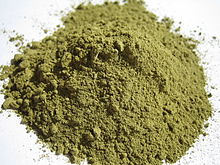 Henna powder is mixed with water and then applied on the hair
Henna powder is mixed with water and then applied on the hair
In a nomadic culture, where one's possessions are frequently moved, there is little reason for the plastic arts to be highly developed. Somalis embellish and decorate their woven and wooden milk jugs (haano; the most decorative jugs are made in Ceerigaabo) and wooden headrests. Traditional dance is also important, though mainly as a form of courtship among young people. The traditional dance known as the Ceeyar Somaali in the Somali language is Somaliland's favourite dance.
Also, an important form of art in Somaliland is henna painting (mehndi, Somali: Xenna). The henna plant is widely grown across the region and it was Arab merchants and settlers that first brought the art of henna painting to early Somaliland. During special occasions, a Somali woman's hands and feet are expected to be covered in decorative mendhi. Girls and women usually apply or decorate their hands and feet in henna on joyous celebrations like Eid or weddings. The henna designs vary from very simple to highly intricate. Compared to Pakistani, Indian or Bangladeshi henna designs, Arab designs are more modern and simple. Traditionally, only women apply this body art, as it is considered a feminine custom.
Henna is not only applied on the hands and feet but is also used as a dye. Somali men and women alike use henna as a dye to change their hair colour. Mostly, elderly men with grey hair apply this procedure because black hair dye is forbidden in Islam. Women are free to apply henna on their hair as most of the time they are wearing a hijab.
See also
- Outline of Somaliland
- Communications in Somaliland
- Public holidays in Somaliland
- Banknotes of the Somaliland shilling
- Coins of the Somaliland shilling
- List of states with limited recognition
- LGBT rights in Somaliland (Gay rights)
References
- ^ a b c "Country Profile". Government of Somaliland. http://www.somalilandgov.com/cprofile.htm. Retrieved 2010-02-02.
- ^ "Somalia". World Factbook. Central Intelligence Agency. 2009-05-14. https://www.cia.gov/library/publications/the-world-factbook/geos/so.html. Retrieved 2009-05-31.
- ^ Paul Dickson, Labels for locals: what to call people from Abilene to Zimbabwe, (Merriam-Webster: 1997), p.175.
- ^ a b c d e Lacey, Marc (2006-06-05). "The Signs Say Somaliland, but the World Says Somalia". New York Times. http://www.nytimes.com/2006/06/05/world/africa/05somaliland.html. Retrieved 2010-02-02.
- ^ The UK Prime Minister's Office Reply To The "Somaliland E-Petition"
- ^ "Republic of Somaliland – Country Profile". Somaliland Mission. http://www.somalilandgov.com/cprofile.htm. Retrieved 30 April 2011.
- ^ "The Transitional Federal Charter of the Somali Republic". University of Pretoria. 2004-02-01. http://www.chr.up.ac.za/hr_docs/countries/docs/charterfeb04.pdf. Retrieved 2010-02-02. "The Somali Republic shall have the following boundaries. (a) North; Gulf of Aden. (b) North West; Djibouti. (c) West; Ethiopia. (d) South south-west; Kenya. (e) East; Indian Ocean."
- ^ a b "Somaliland Marks Independence After 73 Years of British Rule" (fee required). The New York Times. 1960-06-26. p. 6. http://select.nytimes.com/gst/abstract.html?res=F00A10FB395A1A7A93C4AB178DD85F448685F9. Retrieved 2008-06-20.
- ^ a b "How Britain said farewell to its Empire". BBC News. 2010-07-23. http://www.bbc.co.uk/news/magazine-10740852.
- ^ a b Encyclopaedia Britannica, The New Encyclopaedia Britannica, (Encyclopaedia Britannica: 2002), p.835
- ^ a b "The dawn of the Somali nation-state in 1960". Buluugleey.com. http://www.buluugleey.com/warkiidanbe/Governance.htm. Retrieved 2009-02-25.
- ^ a b "The making of a Somalia state". Strategypage.com. 2006-08-09. http://www.strategypage.com/htmw/htwin/articles/20060809.aspx. Retrieved 2009-02-25.
- ^ Analysis: Time for jaw-jaw, not war-war in Somaliland
- ^ a b c "The Constitution of the Republic of Somaliland". Government of Somaliland. 2001-05-01. http://www.chr.up.ac.za/undp/domestic/docs/c_Somaliland.pdf. Retrieved 2010-02-02.
- ^ "Somaliland Celebrates 18 May Independence Day". The Somaliland Times. 2007-05-19. http://www.somalilandtimes.net/sl/2007/278/1.shtml. Retrieved 2010-02-02.
- ^ "De Facto Statehood? The Strange Case of Somaliland". Yale University, Journal of International Affairs. 2008. Archived from the original on 2010-04-18. http://www.webcitation.org/5p4r3fdSg. Retrieved 2010-02-02.
- ^ Schoiswohl, Michael (2004). Status and (Human Rights) Obligations of Non-Recognized De Facto Regimes in International Law. University of Michigan: Martinus Nijhoff Publishers. p. 351. ISBN 9789004136557. http://books.google.com.au/books?id=GOSbAAAAMAAJ&q=Status+and+(Human+Rights)+Obligations+of+Non-Recognized+De+Facto+Regimes+in+International+Law&dq=Status+and+(Human+Rights)+Obligations+of+Non-Recognized+De+Facto+Regimes+in+International+Law&cd=1.
- ^ "Regions and Territories: Somaliland". BBC News. 2009-09-25. http://news.bbc.co.uk/2/hi/africa/country_profiles/3794847.stm. Retrieved 2010-02-02.
- ^ "Chronology for Issaq in Somalia". Minorities at Risk Project. United Nations Refugee Agency. 2004. http://www.unhcr.org/refworld/docid/469f38dbc.html. Retrieved 2010-02-02.
- ^ "Interview with Ambassador Brook Hailu Beshah". International Affairs Review. 2008-11-08. http://www.iar-gwu.org/node/49. Retrieved 2010-02-02.
- ^ FBI investigates Somalis in Minneapolis
- ^ "Reforming Somaliland's Judiciary". United Nations. 2006-01-09. http://www.un.org/webcast/pdfs/unia991.pdf. Retrieved 2010-02-02.
- ^ "Arab League condemns Israel over Somaliland recognition". Ethjournal.com. 2010-03-07. http://www.ethjournal.com/index.php?option=com_content&view=article&id=1503:arab-league-condemns-israel-over-somaliland-recognition&catid=13:headlines&Itemid=19. Retrieved 2010-05-06.
- ^ Hugh Chisholm (ed.), The encyclopædia britannica: a dictionary of arts, sciences, literature and general information, Volume 25, (At the University press: 1911), p.383.
- ^ Samatar, Abdi Ismail (1989). The state and rural transformation in Northern Somalia, 1884–1986. Madison: University of Wisconsin Press. p. 31. ISBN 0299119904.
- ^ Samatar p. 31
- ^ Samatar, p. 32
- ^ Samatar, Unhappy masses and the challenge of political Islam in the Horn of Africa, Somalia Online [1] retrieved 10-03-27
- ^ Samatar, The state and rural transformation in Northern Somaliap. 42
- ^ Tristan McConnell, The Invisible Country," Virginia Quarterly Review, January 15, 2009,[2][dead link] retrieved 2010-03-27
- ^ Greystone Press Staff, The Illustrated Library of The World and Its Peoples: Africa, North and East, (Greystone Press: 1967), p.338
- ^ Moshe Y. Sachs, Worldmark Encyclopedia of the Nations, Volume 2, (Worldmark Press: 1988), p.290.
- ^ a b Somaliland’s Quest for International Recognition and the HBM-SSC Factor
- ^ Lewis, A Modern History, pp. 282–286
- ^ Human Rights Watch (Organization), Chris Albin-Lackey, Hostages to peace: threats to human rights and democracy in Somaliland, (Human Rights Watch: 2009), p.13.
- ^ Somalia: Somaliland appeals for 'cooperation with Puntland' a second time
- ^ Gettleman, Jeffrey (2007-03-07). "Somaliland is an overlooked African success story". The New York Times. http://www.nytimes.com/2007/03/07/world/africa/07iht-somalia.4826198.html. Retrieved 2010-02-04.
- ^ "Opposition leader elected Somaliland president". AFP. Google News. http://www.google.com/hostednews/afp/article/ALeqM5j8hma5FaM4Jn8UUVlRwwK18hpStQ. Retrieved 2010-07-01.
- ^ Somaliland Parliament
- ^ Somaliland Judicial System
- ^ freedomhouse.org: Home
- ^ "Ethiopia Appoints New Representative to Somaliland, Upgrades Its Office". Somaliland Press. 2009-10-30. http://somalilandpress.com/9356/ethiopia-appoints-new-representative-to-somaliland-upgrades-the-office/. Retrieved 2010-02-04.[dead link]
- ^ a b c d e f g "Somaliland closer to recognition by Ethiopia". Afrol News. http://www.afrol.com/articles/25633. Retrieved 2007-07-06.
- ^ "Somaliland, Djibouti in bitter port feud". afrol News. http://www.afrol.com/articles/23556. Retrieved 2007-07-22.
- ^ "France recognizes de facto Somaliland". Les Nouvelles d'Addis. 2008-04-08. http://www.lesnouvelles.org/P10_magazine/15_grandentretien/15055_mahamudsalahnur_eng.html. Retrieved 2010-02-04.
- ^ "Kenyan Deputy Speaker addresses Somaliland parliament". Somaliland Press. 2009-12-24. http://somalilandpress.com/10344/kenyan-deputy-speaker-addresses-somaliland-parliament/. Retrieved 2010-01-02.[dead link]
- ^ "Somaliland Diplomatic Mission in Sweden". http://www.somalilandembassy.se/. Retrieved 2010-04-02.
- ^ "Somaliland". United Kingdom Parliament. 2004-02-04. http://www.publications.parliament.uk/pa/cm200304/cmhansrd/vo040204/halltext/40204h03.htm. Retrieved 2007-02-23.
- ^ "EU Breaks Ice on Financing Somaliland". Global Policy Forum. 2003-02-11. http://www.globalpolicy.org/component/content/article/168/29775.html. Retrieved 2007-02-23.
- ^ "AU supports Somali split". Mail and Guardian Online. 2006-02-10. http://www.mg.co.za/article/2006-02-10-au-supports-somali-split. Retrieved 2007-02-23.
- ^ "Somaliland on verge of observer status in the Commonwealth". Qaran News. 2009-11-16. http://www.qarannews.com/index.php?option=com_content&task=view&id=6381&Itemid=59. Retrieved 2010-02-02.
- ^ "Conditional Recognition Sought For Somaliland By EU Party". The Somaliland Times. 2007-12-01. http://www.somalilandtimes.net/sl/2007/306/027.shtml. Retrieved 2010-02-02.
- ^ "U.S. Debating Shift of Support in Somali Conflict". The Somaliland Times. 2007-12-03. http://www.somalilandtimes.net/sl/2007/307/027.shtml. Retrieved 2010-02-02.
- ^ Shipton, Martin (3 March 2006). "Wales strikes out on its own in its recognition of Somaliland". Wales Online. http://www.walesonline.co.uk/news/welsh-politics/welsh-politics-news/tm_objectid=16766640&method=full&siteid=50082-name_page.html. Retrieved 2010-06-25.
- ^ Ibrahim, Mohamed; Gettleman, Jeffrey (2010-09-26). "Helicopter Attacks Militant Meeting in Somalia". The New York Times. http://www.nytimes.com/2010/09/27/world/africa/27somalia.html?ref=world.
- ^ afrol News – US near de-facto recognition of Somaliland
- ^ "Strengthening the UK's relationship with Somaliland". Ukun.fco.gov.uk. 2010-11-25. http://ukun.fco.gov.uk/en/news/?view=News&id=204732682. Retrieved 2011-03-29.
- ^ "Ahmed Mahamoud Silanyo, President of the Republic of Somaliland – This is Africa". Thisisafricaonline.com. 2011-01-20. http://www.thisisafricaonline.com/feature_button.php?id=20. Retrieved 2011-03-29.
- ^ "Puntland's control over parts of Somaliland". The Somaliland Times. 2006-02-01. http://www.somalilandtimes.net/sl/2005/211/22.shtml. Retrieved 2010-02-02.
- ^ "Awdal "Republic": Declaration of Independence, Somalia". University of Pennsylvania. http://www.africa.upenn.edu/Hornet/awdal.html. Retrieved 2007-01-29.
- ^ "Somaliland: The Myth of Clan-Based Statehood". Somalia Watch. 2002-12-07. http://www.somaliawatch.org/archivedec02/021207202.htm. Retrieved 2007-01-29.
- ^ "Puntland and Somaliland clashing in northern Somalia". Hoehne, Markus. 2007-11-07. http://hornofafrica.ssrc.org/Hoehne/printable.html. Retrieved 2007-12-02.
- ^ "Mimesis and mimicry in dynamics of state and identity formation in northern Somalia". Hoehne, Markus. 2009. http://www.eupjournals.com/doi/abs/10.3366/E0001972009000710?cookieSet=1&journalCode=afr. Retrieved 2009-10-02.
- ^ "Somaliland Defence Forces take control of Las Qorey". Qaran News. 2008-07-09. http://www.qarannews.com/index.php?option=com_content&task=view&id=2016&Itemid=59. Retrieved 2010-04-02.
- ^ Worldstatesmen – Maakhir
- ^ Awdalland Deserves Recognition – New Song (Daawo)
- ^ The Declaration of Adal State
- ^ American Chronicle | Somaliland Navy: The Only Way to stop Somali Piracy
- ^ a b Daniel Harris with Marta Foresti 2011. Somaliland's progress on governance: A case of blending the old and the new. London: Overseas Development Institute
- ^ "Remittances a lifeline to Somalis". Global Post. 2009-07-04. http://www.pulitzercenter.org/openitem.cfm?id=1687. Retrieved 2010-04-02.[dead link]
- ^ Somaliland Republic : Country Profile
- ^ "Middle East Policy Council – Muslim Populations Worldwide". Mepc.org. 2005-12-01. http://www.mepc.org/workshops/popstat.asp. Retrieved 2010-05-06.[dead link]
- ^ Somalia. United States Department of State. August 2009. Retrieved 2009-10-06.
- ^ Mohamed Diriye Abdullahi, Culture and Customs of Somalia, (Greenwood Press: 2001), p.1
- ^ I. M. Lewis, Saints and Somalis: popular Islam in a clan-based society, (The Red Sea Press: 1998), p.11.
- ^ Somaliland Constitution
- ^
 "Somaliland". Catholic Encyclopedia. New York: Robert Appleton Company. 1913.
"Somaliland". Catholic Encyclopedia. New York: Robert Appleton Company. 1913.
Sources and references
 This article incorporates text from a publication now in the public domain: Herbermann, Charles, ed (1913). "Somaliland". Catholic Encyclopedia. Robert Appleton Company. CATHOLIC ENCYCLOPEDIA: Somaliland
This article incorporates text from a publication now in the public domain: Herbermann, Charles, ed (1913). "Somaliland". Catholic Encyclopedia. Robert Appleton Company. CATHOLIC ENCYCLOPEDIA: Somaliland- Wales Strikes Out On Its Own In Its Recognition of Somaliland
- Hoehne, Markus V. 2009: Mimesis and mimicry in dynamics of state and identity formation in northern Somalia, Africa 79/2, pp. 252–281.
- Hoehne, Markus V. 2007: Puntland and Somaliland clashing in northern Somalia: Who cuts the Gordian knot?, published online on 7 November 2007. http://hornofafrica.ssrc.org/Hoehne/
Bibliography
- Bradbury, Mark, Becoming Somaliland (James Currey, 2008)
External links
- Somaliland official website
- Somaliland Net Somali and English language news website.
- Somaliland Today Arabic language news website.
- Somaliland Press English language news website.
- Somaliland.Org news website (primarily Somali language; some English)
- Somaliland Times English language news website.
- Somaliland BBC Country Profile
- Update on the Situation in the Somaliland
- United Kingdom parliamentary debate on recognition of Somaliland, February 4, 2004 led by Tony Worthington
- Somaliland recognition finds enhanced support
- Somaliland strives to stand out in troubled region, May 17, 2009 LA Times
- To beat piracy on the high seas, UN and India should recognise Somaliland June 30, 2010 Daily Telegraph
Somaliland Politics Constitution · President · Cabinet · Parliament · Elections · Political parties · Politicians · Military · Human rights · Foreign relations · Flag · Emblem · AnthemHistory Geography Economy Society Culture · Demographics · Somali people · Somali diaspora · Languages · Literature · Cuisine · Public holidays · IslamOutline · Portal
See also: Outline of Somalia Somalia
SomaliaCapital: Mogadishu Topics Maritime history · Laas Gaal · Land of Punt · Walashma dynasty · Warsangali Sultanate · Adal Sultanate · Ajuuraan State · Dervish State · Gobroon Dynasty · Majeerteen Sultanate · Sultanate of Hobyo · Italian Somaliland · British Somaliland · Ogaden War · Somalian Revolution (1986–1992) · History of Somalia (1991–2006) · Somali Civil War · Unified Task Force · Piracy in Somalia · War in Somalia (2006–2009) · War in Somalia (2009–)Architecture · Art · Cinema · Cuisine · Languages · Literature · Music · Christianity · Islam · Sports · Coat of arms · Flag · National anthemPost-war divisions Declared statesIslamist administrationsFormer administrationsProposed statesPre-war divisions Awdal · Bakool · Banaadir · Bari · Bay · Galguduud · Gedo · Hiiraan · Jubbada Dhexe · Jubbada Hoose · Mudug · Nugaal · Sanaag · Shabeellaha Dhexe · Shabeellaha Hoose · Sool · Togdheer · Woqooyi GalbeedOutline · Index · Portal Countries and territories bordering the Indian Ocean Africa Comoros · Djibouti · Egypt · Eritrea · France (Mayotte and Réunion) · Kenya · Madagascar · Mauritius · Mozambique · Rodrigues, Mauritius · Seychelles · Somalia · Somaliland (Unrecognized) · South Africa · Sudan · Tanzania · Zanzibar, TanzaniaAsia Bahrain · Bangladesh · British Indian Ocean Territory (Chagos Archipelago), United Kingdom · Burma · Christmas Island and Cocos (Keeling) Islands, Australia · India · Indonesia · Iran · Iraq · Israel · Jordan · Kuwait · Malaysia · Maldives · Oman · Pakistan · Qatar · Saudi Arabia · Sri Lanka · Thailand · Timor-Leste · United Arab Emirates · YemenOther Africa Sovereign
states- Algeria
- Angola
- Benin
- Botswana
- Burkina Faso
- Burundi
- Cameroon
- Cape Verde
- Central African Republic
- Chad
- Comoros
- Democratic Republic of the Congo
- Republic of the Congo
- Côte d'Ivoire (Ivory Coast)
- Djibouti
- Egypt
- Equatorial Guinea
- Eritrea
- Ethiopia
- Gabon
- The Gambia
- Ghana
- Guinea
- Guinea-Bissau
- Kenya
- Lesotho
- Liberia
- Libya
- Madagascar
- Malawi
- Mali
- Mauritania
- Mauritius
- Morocco
- Mozambique
- Namibia
- Niger
- Nigeria
- Rwanda
- São Tomé and Príncipe
- Senegal
- Seychelles
- Sierra Leone
- Somalia
- South Africa
- South Sudan
- Sudan
- Swaziland
- Tanzania
- Togo
- Tunisia
- Uganda
- Zambia
- Zimbabwe
States with limited
recognition- Sahrawi Arab Democratic Republic
- Somaliland
Dependencies and
other territories- Canary Islands / Ceuta / Melilla / Plazas de soberanía (Spain)
- Madeira (Portugal)
- Mayotte / Réunion (France)
- Saint Helena / Ascension Island / Tristan da Cunha (United Kingdom)
- Western Sahara
Sovereign
states- Algeria
- Angola
- Benin
- Botswana
- Burkina Faso
- Burundi
- Cameroon
- Cape Verde
- Central African Republic
- Chad
- Comoros
- Democratic Republic of the Congo
- Republic of the Congo
- Côte d'Ivoire (Ivory Coast)
- Djibouti
- Egypt
- Equatorial Guinea
- Eritrea
- Ethiopia
- Gabon
- The Gambia
- Ghana
- Guinea
- Guinea-Bissau
- Kenya
- Lesotho
- Liberia
- Libya
- Madagascar
- Malawi
- Mali
- Mauritania
- Mauritius
- Morocco
- Mozambique
- Namibia
- Niger
- Nigeria
- Rwanda
- São Tomé and Príncipe
- Senegal
- Seychelles
- Sierra Leone
- Somalia
- South Africa
- South Sudan
- Sudan
- Swaziland
- Tanzania
- Togo
- Tunisia
- Uganda
- Zambia
- Zimbabwe
States with limited
recognition- Sahrawi Arab Democratic Republic
- Somaliland
Dependencies and
other territories- Canary Islands / Ceuta / Melilla / Plazas de soberanía (Spain)
- Madeira (Portugal)
- Mayotte / Réunion (France)
- Saint Helena / Ascension Island / Tristan da Cunha (United Kingdom)
- Western Sahara
Categories:- Somaliland
- Divided regions
- East Africa
- English-speaking countries and territories
- Geography of Somalia
- Unrecognized or largely unrecognized states
- States of Somalia
- Gulf of Aden
- States and territories established in 1991
- Secession in Somalia
- Somali Civil War
Wikimedia Foundation. 2010.

